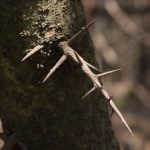 TREE LIFE 536
TREE LIFE 536
APRIL 2025
PLANNED EVENTS: APRIL
Since inclement weather or other issues may vary our plans, WhatsApp Tony Alegria on 0772 438 697 to join our WhatsApp group for last minute updates.
Saturday 5th April 2025: visit to the National Botanic Gardens. Meet at 8.30 in the main car park and join us for a morning looking at trees that catch our interest.
Main meeting Sunday 20th April 2025: We meet at Don Lapham’s property, 31A Willowmead Lane at 9.30 on Easter Sunday for a celebration involving Trees and Easter Eggs. (Tony and Mark did their first “Street Tree Walk” on Willowmead Lane last year with a repeat in March this year, the write up of which is included in this issue of Tree Life).
Please check your WhatsApp for details (including “weather” the outing has been finalised due to rainy conditions!)
ADVANCED NOTICE OF EVENTS: MAY 2025
The 75th Annual General Meeting of The Tree Society of Zimbabwe:
will be held at the home of Bill and Fiona at Val d’Or on Sunday 11th May 2025 at 9.30 a.m., Details under “The Walrus and the Carpenter” below
WANTED
We are often asked by folk who have a genuine use for a copy of A New Zimbabwean Botanical Check List of English and African Plant Names (The vernacular names book) by L J Mullin. These were originally given to members at no cost, but if you find you are not using yours, please hand it over to Tony or one of the committee.
REPORTS FROM PREVIOUS OUTINGS
Saturday 1st March 2025: National Botanic Garden Outing
By Tony Alegria
On a cloudy morning, having had rains the previous day, 2 ladies and 6 men; namely Dawn Siemers and Firle Davies plus Charles Crawshaw, Jono Wood, Mark Hyde, Paul Grobler, Stuart Wood and Tony Alegria.
After the walk Firle and Jono became members of the Tree Society. It looked like it could rain at any moment but the prediction was for no rain in the morning and that proved to be the case.
We started the morning off by having a brief chat about acacias in general and then went off to see some of them. Below I have added a bit to the brief chat!
Vachellia and Senegalia
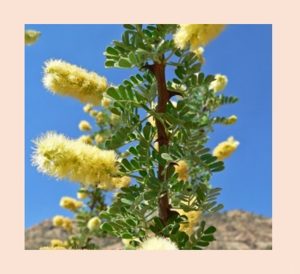
Senegalia: curved thorns and elongated flower heads
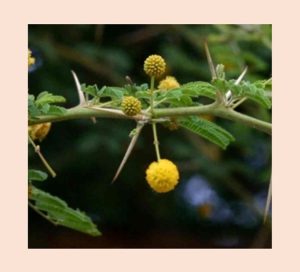
Vachellia: straight thorns and round flower heads
Acacias are basically divided into two groups, those with straight thorns which grow from the wood and those with curved thorns (prickles) which are only skin deep and can be snapped off as can be done with rose prickles. Those with straight thorns, now named Vachellia, have small ball-shaped flowers in colours of white, cream or yellow. Those with prickles, now named Senegalia, have flowers in spikes which are white or cream.
[NB – editor’s note. As with everything, there are exceptions, some species of Senegalia have ball-shaped flowers – for example S. schweinfurthii, the river climbing acacia. But ALL Vachellia have ball-shaped flowers, none has spikes].It is to be noted that the flowers of the Senegalia (Acacia) galpinii, the Monkey Thorn, have a purple tinge due to the purple calyces.
There are three acacias that can have really corky bark, these being Senegalia (Acacia) galpinii, Vachellia (Acacia) abyssinica, the Nyanga flat-top, and Vachellia (Acacia) sieberiana, the Paperbark acacia. Like most rules there are exceptions! When young, acacias have many thorns to protect them from being eaten, but some lose their thorns as they grow larger as the threat to be eaten lessens.
We first looked at the acacias in the car park –Vachellia sieberiana, Vachellia karroo, Vachellia abyssinica and Senegalia polyacantha, the White thorn.
Of the five V. abyssinica trees, three have been cut down, one is still standing but dead, only one is still alive. It must be noted that near the Herbarium there were at least ten V. abyssinicas which have all died and been removed. The only other one, which is on the map of the Garden numbered 34, is also dying.
Opposite the restaurant there are a couple of Vachellia xanthophloea, the Fever tree, the boles of which were too thin to take a nail for the label only about five years ago, are now pretty big!
Recently discovered by Mark whilst tree labelling is a bushy three-hook acacia with three hooked prickles – two pointing up and one pointing down, a Senegalia senegal var. rostrata.
We then had a look at another fairly recent discovery – Senegalia eriocarpa, the Woolly-pod acacia with big leaves but it is not a big tree. This acacia is fairly unique in that it has stipules when the leaves are very young.
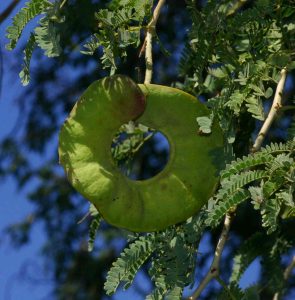
Faidherbia albida
And now for something completely different Faidherbia albida:
We looked at the Acacia albida, also known as the Ana tree or Apple-ring acacia and which, unlike all the other acacias, had no leaves at all. It is about to come into leaf really soon. So, it will have leaves and fruit during the dry months and provide food for animals – their big pods are relished by livestock and game. Therefore, this tree behaves totally different to the acacias and thus has been renamed Faidherbia albida – a single species in the genus! There are quite a few of these trees in Harare – many in Msasa.
Also in the gardens there is a single Vachellia kirkii, on which we have never seen any flowers or the very distinctive diagnostic fruit.
Some of the trees we saw that are not mentioned above:
Vachellia grandicornuta with very long thorns;
Vachellia natalitia; and
Senegalia nigrescens.
Main meeting 16th March 2024: Visit to Greystone Park Nature Preserve
By Mark Hyde, Pictures by Jim Dryburgh and Mark Hyde
The following members gathered in the Greystone Nature Preserve car park off Halford Road: Tony Alegria, Jim Dryburgh, Soo Fawcett, Busi Malunga, Jan van Bel, Karl van Laeren and myself. In addition we had two enthusiastic visitors, Carola and Ben, Italian and Belgian respectively with their two children.
Although the season’s rainfall has not been all that great and this was demonstrated by the almost totally dry dam, the vegetation was still looking green and in good condition and there was plenty to see, of both trees and herbaceous plants.
We started off by looking at some of the trees in the car park, where there is a very fine Senegalia (Acacia) galpinii, Monkey thorn. It has a large trunk which Karl measured to be 3.9 m in circumference. This species makes a fine garden subject with its large, graceful leaves. It is deciduous and is one of the first acacias to burst into flower and has red buds and creamy flower spikes. The status of this species in Harare is not easy to determine. Most occurrences are clearly planted but although native specimens occur not far from Harare, my view is that the plants are either planted or have become naturalised from the cultivated trees.
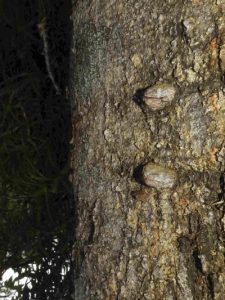
Senegalia polyacantha, the White thorn acacia
Nearby was Senegalia (Acacia) polyacantha, the White thorn. This had thorns on raised bosses on the trunk. These bosses seem only to occur on species of Senegalia, never Vachellia, and are most developed in the Knob thorn, Senegalia nigrescens.

Rhamnus prinoides
Also in the car park was Rhamnus prinoides, Shiny leaf, a species of damp habitats, often near streams. This specimen was flowering, a little late and out of season. The species name prinoides is nothing to do with the genus Prunus; it originates from the Greek prinos, meaning Holly (Ilex sp.) which also has glossy leaves.
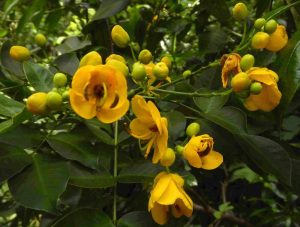
Senna septemtrionalis
Next to this was an exotic species of Senna, namely Senna septemtrionalis, Smooth senna. This was in full yellow flower. We noted the paripinnate leaves with 3-4 pairs of leaflets with glands between some or all of the pairs. This is a native of Mexico and Central America; it is occasionally cultivated in gardens but is now well naturalised, mostly in the higher rainfall areas of Zimbabwe.
Instead of taking our usual route on to the dam wall and thence down below it into the riverine area, we headed off along the path which had been cut amongst the tall grass along the side of the dam parallel to Halford Road.
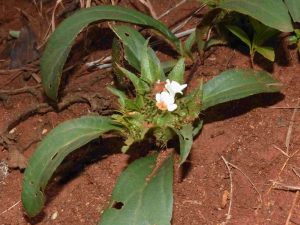
Crabbea cirsioides
Here were numerous plants of a low growing species in the Acanthaceae family, Crabbea cirsioides. Incredibly this is the first time I have seen it here and there was lots of it. I have been visiting the Preserve since the 1990s and have never seen it before. I have also never seen it around Harare at all although there is an old record from Borrowdale Common.
The genus Crabbea, not to be confused with the better-known legume tree genus, Craibia, is named after an English poet, George Crabbe, who lived from 1754 to 1832.
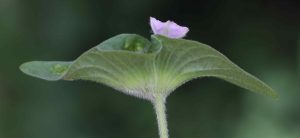
Ipomoea pileata
Later I came across another rare plant, rare at least near Harare, named Ipomoea pileata. It is a very distinctive morning-glory in which the inflorescence is held within a wide boat-shaped bract.
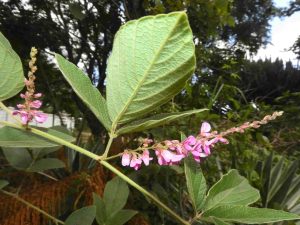
Pseudarthria hookeri
At the corner of Halford and Gaydon, there is a little grove of planted succulents, Euphorbia cooperi subsp. cooperi, E. ingens and what was probably E. griseola subsp. mashonica. The latter species had a lot more leaves on it than usual. Nearby was Zanha africana, the Velvet-fruited Zanha, and a Violet tree, Securidaca longipedunculata.
A specimen of Pseudarthria hookeri was also nearby. We were able to demonstrate the Velcro-like nature of its leaves to the children.
There is no doubt that the Preserve is a very interesting place botanically, partly because of the huge influx of exotic species, but as we also saw on this day with the Crabbea and the Ipomoea pileata, excellent for indigenous species as well.
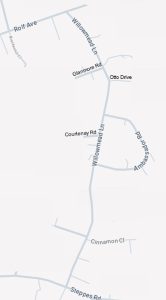 Trees of Willowmead Lane
Trees of Willowmead Lane
NOTE: All species of acacia have been given their specific genus name, Vachellia or Senegalia.
In the street
by Tony Alegria
Some time ago, 7th May 2024, Mark Hyde, Jan van Bel and I walked and recorded the street and garden trees in Willowmead Lane. Unfortunately, at that point in time, we were too busy to do a write up of what we saw. Months later, we had forgotten what we saw and thus did it again. Well, today 11th March 2025, we repeated the walk having exchanged Jan van Bel for Paul Grobler. I found the second time round just as interesting as the first walk. Willowmead Lane ends with a T-junction at both ends – one end at Steppes Road and the other at Rolf Avenue.
We began our tree walk at the Rolf Avenue end as we had parked our vehicles at Kava and at the Oak Tree Restaurant. We walked towards Steppes Road facing the oncoming traffic, which is on the western side of the road, as Willowmead Lane runs almost North-South. Once we reached Steppes Road we crossed over Willowmead Road for the return trip once again facing the traffic.
he first section near Rolf Avenue is totally wild and slopes up to the property walls quite a lot. Recently the Bauhinia variegata trees had been lopped at about three meters high but, apart from those, there were all sorts of things growing there – Agave species, Lantana, Celtis africana, Poinsettias, Euphorbia ingens, Msasas, Mauritian thorn, bug weed, Ficus burkei, just to name a few. On the other side of the road is a wooden fence around a car park with a few acacias as street trees – namely Vachellia sieberiana and Vachellia abyssinica.
Once around the corner and past the hill, the land is flattish. Here were a couple of pine trees – probably Pinus roxburghii and a Bougainvillea/Privet hedge which, like the other hedges, had many plants growing inside it including Toona ciliata, which can become a really big tree. Next to the road was a mango tree and some Poinsettias.
Further along at the corner of Glanmore Road, there were many small trees on both corners comprising Dovyalis afra, Dovyalis zeyheri, Flacourtia indica, Piliostigma thonningii, Schotia brachypetala, Sausage trees, Celtis africana etc. This contrasted against some properties where there were no street trees at all!
Some walls were just brick whilst others were covered with Creeping fig Ficus pumila or a large leaved Ivy. Property No. 22 had crisscross Ivy patterns on the high walls and a Chinese guava on either side of the gate along with greenish yellow low Duranta erecta hedges. In fact, there were a few entrances lined with these forget-me-not hedges as well as trimmed “ball-shaped” bushes here and there. Property No. 20 was unique as it had some 20 Duranta erecta bushes trimmed into balls up to head height!
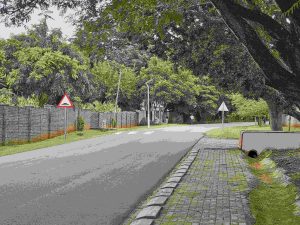
Typical Willowmead Lane
The road then dips where the beginnings of a river crosses the road. On the western side there is a clump of Phoenix reclinata palms and a Water berry Syzygium cordatum, whilst on the other side of the road are four Jatropha integerrima bushes.
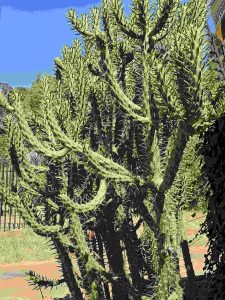
Austrocylindropuntia
Near Ambassador Road is the only bit of road with sizeable trees on both sides. There are four Tipuana tipu and a Ficus microcarpa. Also there were a few more acacias – Vachellia karroo, Vachellia abyssinica and an Vachellia sieberiana with a small Mexican apple tree beneath it. Then there followed sixteen young acacias, this time Senegalia galpinii. Also, along this stretch, there were some Brush cherries Syzygium paniculatum and some more young Senegalia galpinii.
There is a road leading to a pan-handle property with two rather tall Jasminum mesnyi on the left side of a ZESA transformer, whilst on the other side against a wall is a cactus. This cactus Austrocylindropuntia subulata (Opuntia exaltata), is native to Peru, Ecuador and Bolivia. An interesting cactus as it has thorns and small cylindrical leaves as well as the green stems which are also cylindrical. Fruits look like prickly pears.
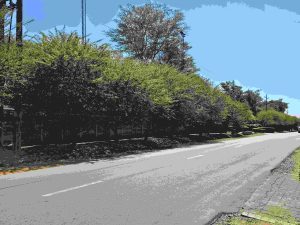
Vachellia nilotica street trees
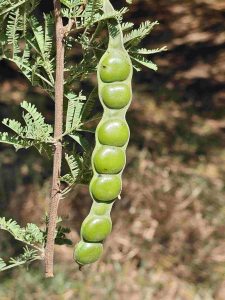
Vachellia nilotica fruit
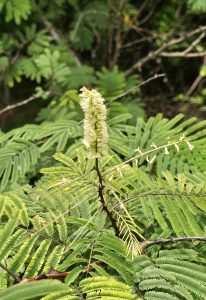
Senegalia ataxacantha flower
The last property on the corner of Steppes Road was very interesting in that it had a wall covered with Creeping fig Ficus pumila and had trimmed Bougainvillea bushes along with thorny creeping acacias in the form of Senegalia schweinfurthii and Senegalia ataxacantha. Not only that, but in front were 23 Vachellia nilotica 4-metre-high thorn trees, many with the diagnostic fruit.
There are not too many trees on the eastern side of the road, a few large Jacarandas, young leopard trees and in front of No. 30 were three Camphor trees Cinnamomum camphora, as well as three Forest big-leaf Anthocleista grandiflora. trees. In front of another wall there were eight small trees with chocolate-coloured leaves, Euphorbia cotinifolia, commonly known as the Caribbean Copper Plant, which is native to Mexico and South America.
Some of the other trees seen but not mentioned above: Rubber tree hedge Euphorbia tirucalli, Combretum molle, Bug tree Solanum mauritianum, Bauhinia variegata, Cotoneaster, Munondo, Phyllanthus reticulatus, Royal Cuban palms, Kenyan croton Croton megalocarpus, Large-leaved fig Ficus lutea, Lady Chancellor Citharexylum spinosum, Flamboyant Delonix regia, Queen palm, coppicing Dombeya rotundifolia, small guava trees and Cape honeysuckle Tecomaria capensis.
In the gardens
by Mark Hyde
It was Tony’s idea to walk the 1.4 km length of Willowmead Lane recording trees and also his idea to split the recording between street and garden trees with him writing up the street trees and me doing those in gardens. Although we must have looked a distinctive and perhaps unusual group, no-one questioned why, armed with a camera and GPS, we were peering over garden walls.
In total 85 species of tree, shrub or woody climber were successfully identified in gardens. Because we could not always get close, it tended to be the larger specimens which were successfully named. Of the 85, only 24 (28%) were indigenous, a low percentage, perhaps because there was very little native woodland in these particular gardens.
The gardens were in many cases mature and there were some fine specimens of such species as Kenya coffee shade tree Acrocarpus fraxinifolius, Smooth-barked flat-crown Albizia gummifera, Msasa Brachystegia spiciformis, Malay banyan Ficus microcarpa, and, as one might expect, the Jacaranda.
Nine species of fruit tree were seen, namely: Pecan Carya illinoinensis, Mexican apple Casimiroa edulis, a species of Macadamia, Simple-spined num-num Carissa_spinarum (edulis), Loquat Eriobotrya japonica, Mango Mangifera indica, Avocado Persea americana, Guava Psidium guajava and Pomegranate Punica granatum.

Lagunaria patersonia flower and fruit
It was not a rich time of the year for flowering trees but there was an enormous Silk cotton tree Ceiba speciosa, covered in pink flowers. A somewhat unusual species seen was Lagunaria patersonia, the Norfolk Island hibiscus or itch tree. So called because of the white ‘fibre-glass’ hairs inside the fruit capsule. These may be spread around the area near these trees and are highly irritant.
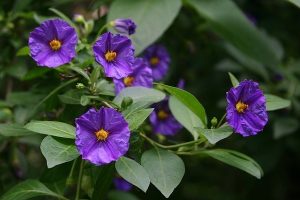
Lycianthes rantonnetii
Lycianthes rantonnetii, also known as the blue potato bush or Paraguay nightshade, was seen. This resembles a species of Solanum and indeed was previously classified as Solanum rantonnetii but has since been reclassified to the genus Lycianthes. It is a very floriferous and attractive species commonly grown in Harare.
On the two walks, I also recorded the herbaceous flora as well as the trees and we ended up with an impressive list of 218 plant species from street and gardens combined. Included in that were 10 species of acacia (6 Vachellia and 4 Senegalia). This shows the diversity of urban floras and one should note that the grass and sedge floras were only cursorily examined and there are no doubt more to be recorded.
The street flora was much richer than the gardens, mainly because we could not see the small plants over the walls.
Street habitats encountered were:
- Well-clipped lawns supporting plants that tolerate trampling and cutting
- Wild verges containing grassland species
- Areas of disturbance
- Ditches providing seasonally wet habitats
- Walls supporting creepers and climbers
- A small area of exposed bare rock which surprisingly produced Aeollanthus rehmannii, a characteristic rocky species one would not expect in a suburban road.
Amongst the herbaceous flora, there were a couple of unusual things. Momordica charantia (rare in the city, first recorded for Harare in East Road in 2017) and a small, yellow-flowered annual weed, still to be named but probably new to the city.
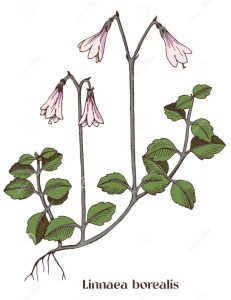 FROM THE WALRUS TO THE CARPENTER
FROM THE WALRUS TO THE CARPENTER
Carl Linnaeus, Prince of Botanists, a man of his time
There once was a Swede, Linnaeus named,
Whose system of naming, was famed.
With genus and species,
In Latin, he’d appease,
The world’s need to classify, it’s claimed.
Most botanists have heard of Carl Linnaeus and there is a wealth of detail about the man and his achievements on the internet so I have chosen a few stories from Wikipedia that help us understand the man.
He was born in southern Sweden in 1707 and he and his father, an amateur botanist, spent much time in the garden where Linnaeus learnt the names of the flowers.

Linnaeus in the traditional dress of the Sami holding a Twinflower
His first years at school were not successful as spent more time in the countryside looking for plants than at his books. However, in his final year at school he was lucky enough to have a head teacher who noticed his interest in botany and helped him into the field of academia, going on to study Greek, Hebrew, theology, mathematics and medicine.
When working towards his degree, he submitted a dissertation in which he laid out his hypothesis that malaria arose only in areas with clay-rich soils. Although he failed to identify the true source of disease transmission (i.e., the Anopheles mosquito), he did correctly predict that Artemisia annua (Wormwood) would become a source of antimalarial medications.
His first major expedition was to Lapland to find new plants, animals and possibly valuable minerals. He was an eclectic person and was also curious about the customs of the native Sami people, reindeer-herding nomads who wandered Scandinavia’s vast tundras. Travelling on foot and horse, he took with him his journal, various botanical and ornithological manuscripts and sheets of paper for pressing plants. Although Lapland is a region with limited biodiversity, Linnaeus described about 100 previously unidentified plants.
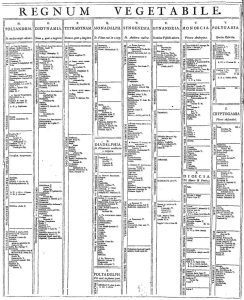
He struggled with the naming systems of his day, trying to make sense of the diversity of the natural kingdom and was probably the first person to play animal, vegetable and mineral and make use of spreadsheets and databases! YES, read on. Linnaeus began giving lectures in botany at the age of 23, and 5 years later, he published the first edition of his
Systema Naturae (animale, vegetabile and lapideum),
the first use of the binomial nomenclature he developed for the natural world.
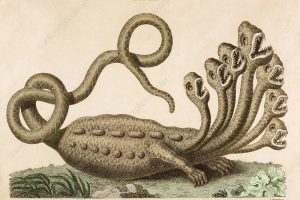
The Hamburg hydra
In April 1735, while in the city of Hamburg, the mayor proudly showed them a supposed wonder of nature in his possession: the remains of a seven-headed hydra. Linnaeus quickly discovered the specimen was a fake, cobbled together from the jaws and paws of weasels and the skins of snakes. Linnaeus suggested that it had been manufactured by monks to represent the Beast of Revelation, and when he made his observations public, dashing the mayor’s dreams of selling the hydra for an enormous sum, he was forced to flee from Hamburg.
His life became one of “networking” with well-known botanists from other countries, publishing books and working in botanical collections both in documenting and developing methods of classification. In May 1741, Linnaeus was appointed Professor of Medicine at Uppsala University, and became responsible for the Botanical Garden and proceeded with his interest in the medicinal aspects of plants.
Linnaeus was of medium height, thin, brown-eyed, hasty, walked quickly, did everything promptly, could not stand lateness; was quickly moved, sensitive, worked continuously; could not spare himself. He enjoyed good food and drank good drinks but was never inebriated by them. He cared little for appearance and believed that the man should embellish the clothes and not vice versa. He was certainly not argumentative, so he never answered those who wrote against him and said:
“If I am wrong, I will not win, and if I am right, I will be shown to be right as long as Nature exists.”
In 1750, Linnaeus became rector of Uppsala University, where his most important contribution was to teach the students to think for themselves and not trust anybody, not even him. He led his students on botanical excursions every Saturday during the summer to explore the flora and fauna in the vicinity of Uppsala. Seventeen of his students, whom he called “apostles”, went on to make botanical expeditions to various places in the world, helping him to further develop his system of taxonomy which spread through the world without Linnaeus ever having to travel outside Sweden.
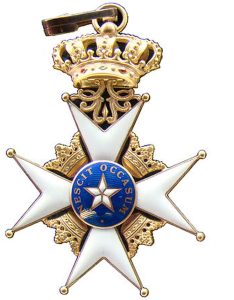 In 1753, the king dubbed him Knight of the Order of the Polar Star, the first civilian in Sweden to become a knight in this order. He was then seldom seen not wearing the order’s insignia. Then in 1757, King Adolf Frederick granted Linnaeus nobility, which took effect in 1761, whereupon he took the name Carl von Linné, the ‘von’ signifying his ennoblement and which is why we have the Linnean Society, not the Linnaean Society!
In 1753, the king dubbed him Knight of the Order of the Polar Star, the first civilian in Sweden to become a knight in this order. He was then seldom seen not wearing the order’s insignia. Then in 1757, King Adolf Frederick granted Linnaeus nobility, which took effect in 1761, whereupon he took the name Carl von Linné, the ‘von’ signifying his ennoblement and which is why we have the Linnean Society, not the Linnaean Society!
 The family’s coat of arms prominently features a twinflower, one of Linnaeus’ favourite plants; it was given the scientific name Linnaea borealis in his honour. The shield in the coat of arms is divided into thirds: red, black and green for the three kingdoms of nature (animal, mineral and vegetable); in the centre is an egg for the method by which nature is perpetuated. At the bottom is the phrase “Famam extendere factis”: we extend our fame by our deeds.
The family’s coat of arms prominently features a twinflower, one of Linnaeus’ favourite plants; it was given the scientific name Linnaea borealis in his honour. The shield in the coat of arms is divided into thirds: red, black and green for the three kingdoms of nature (animal, mineral and vegetable); in the centre is an egg for the method by which nature is perpetuated. At the bottom is the phrase “Famam extendere factis”: we extend our fame by our deeds.
While his reputation had spread over the world and he corresponded with many different people, Linnaeus continued teaching and writing for more than 10 years after he retired, only winding down at the end of 1772 due to his declining health.
Linnaeus’s last years were troubled by illness. He had had a disease called the Uppsala fever, a haemorrhagic fever caused by a virus carried by bank voles in Sweden. He suffered two strokes and eventually died on 10 January 1778. He is buried in Uppsala Cathedral.
His library and collections, consisting of 14,000 plants, 3,198 insects, 1,564 shells, about 3,000 letters and 1,600 books were eventually bought by a 24-year-old medical student, James Edward Smith. They became the foundation of the Linnean Society of London.
REF: Wikipedia: https://en.wikipedia.org/wiki/Carl_Linnaeus
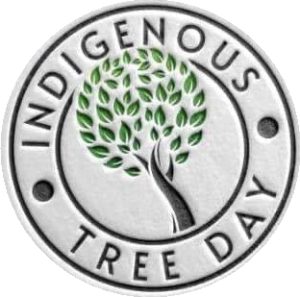 INDIGENOUS TREE DAY: 15 APRIL
INDIGENOUS TREE DAY: 15 APRIL
Reasons to plant an indigenous forest.
By Jennifer Coltart and Ray Perry
- Utilise indigenous trees which are adapted to our climate particularly our periods of drought.
- Create a showcase of our indigenous flora and a place where people can learn to identify them and learn their various values.
- Create a forest which may serve to preserve our indigenous tree species. It may later be used as a seed bank.
- Grow trees in a sustainable way by recreating an “indigenous forest”. The multi-layers of indigenous trees, shrubs, herbs and grasses, relatively densely planted, will likely create a forest floor that will be receptive to seed germination and the nurture of saplings. We hope the forest becomes increasingly dense and will never need to be replanted so long as it is not destroyed.
- The diverse indigenous plant species will also help create a habitat that facilitates biodiversity within both the animal and plant kingdoms.
- Create a cool area of public space where members of the public can seek refuge in the heat, a comfortable environment for families to enjoy with their children and their elderly.
- Create space where the public can draw near to nature for health benefits.
- Enhance the air quality of our Central Business District and mitigate the effects of climate change.
The Bulawayo Centenary Park Indigenous Pocket Forest
By Jennifer Coltart and Ray Perry
In partnership with the Bulawayo City Council we have planted our first Pocket Forest in Centenary Park in 2024 using over 100 species of Indigenous plants. The aim of this pilot project was primarily to start replacing very old Colonial-era exotics, many of which are progressively dying, with a dense, biodiverse-rich mix of indigenous trees, shrubs, herbs, succulents, aloes and grasses.
The concept of planting Urban Indigenous Pocket Forests is becoming increasingly popular in several cities around the world. We were influenced by the Miyawaki Method, https://www.chelseagreen.com/2024/the-miyawaki-method/, and adapted it for our drier conditions by adopting a planting not as dense as recommended, but a lot more dense than traditional planting in our part of the world.
Starting the forest
An area of about 1/3 of an acre was set aside for this project. It is very close to the main gate, visible from the main gate and with access to water. A new forest requires a few years of nurturing until it creates its own micro-climate that allows it to nurture itself. But until then, we would need to water, albeit not intensely.
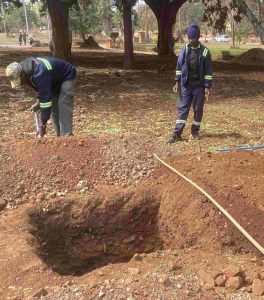 Holes
Holes
We prepared 25 holes of 1 cubic meter each. Subsoil was removed and the hole was filled with a mixture of topsoil, humus and sludge provided from Thorngrove sewage works and 500g of single super phosphate per hole.
Trees
100 different species of trees and smaller plants were used with 4 per hole, from September to November 2024. Ray Perry in Germany kindly assisted with researching combinations for each hole. For example, he placed species that grow in similar habitats together and tried to get a mix of different sizes in each hole, hoping to eventually achieve an emergent layer, canopy, understorey, shrub layer, herb layer and forest floor.
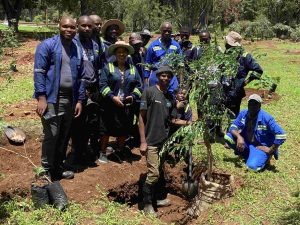
We hope to plant more shrubs, herbs and grasses in future because, up until now, not many of these have been available at indigenous plant nurseries. Amos Maramba from Ray Perry Indigenous Tree Nursery in Bulawayo provided on-site professional implementation of this quite complex construct, giving consideration to how much sun, shade and moisture was available. We just worked with the one soil type we had.
Additional efforts
All the holes have small soil walls to create a dam with 5 cm of mulch covering the hole. Planting was done in September, October and November 2024 and they were watered weekly or more frequently in our early, hot, dry months and again if we had long periods in summer without rain. Going forward, they will be watered once a month.
All the trees have handmade labels giving their Latin, English, Ndebele and Shona names.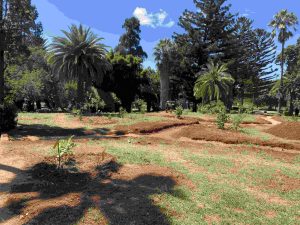
The ground between the holes is covered with natural grass, which is slashed only from time to time, especially while the trees are small. In time we hope to add to the diversity of grasses, aloes, wild flowers and other vegetation.
A pathway meanders through the forest to encourage people to walk through the forest and, hopefully to limit compaction from walking on the forest floor beneath the trees. Areas have been set aside for benches as a future development.
For the future
We are holding the official opening on 15th April to celebrate Indigenous Tree Day with the invited guest of honour the Tree Society’s Sibusiso Malunga (Busi).
We hope that this will be the first of many Bulawayo Pocket Forests and have already had a request to plant another in our Western Park. We also hope to learn from this first experimental planting, such things as are the holes big enough to accommodate 4 plants and what are suitable species mixes. There are bound to be some failures such as species which won’t tolerate Centenary Park’s environment because of frost, their preference for rocky areas or because they are normally only found in central and eastern Zimbabwe – only time will tell.
We are also encouraging nurseries to expand their species selection, especially focusing on Matabeleland plants and the smaller plants; shrubs, sub-shrubs, herbs, aloes, succulents bulbs, ferns and grasses. Many of these smaller plants will add a lot of colour to the forest floor.
Many of the 100+ planted species are nutritionally, medicinally, economically and culturally significant, and we hope to encourage schools to undertake projects whereby they visit the forest and be tasked to write about their significance and uses.
ADDITIONAL NOTES:
EDITORS – Given the coming dry season, April is not really the time of year for us to start planting; however, it is the time of year when we can celebrate what we have achieved in the rainy season and start planning for the longed-for rains at the end of the year.
SUGi – https://www.sugiproject.com/forests All SUGi Forests is an American conservation organization and app that supports afforestation. Founded in 2019, the platform seeks to increase biodiversity through native plant rewilding projects. Employing the Miyawaki method, SUGi has funded over 236 projects and forests in 52 cities. We in Bulawayo are not a member of SUGi, nor have we employed all of the Miyawaki methods but according to their records we now have the most bio-diverse pocket forest in Africa.
THE ANNUAL GENERAL MEETING
OF THE TREE SOCIETY OF ZIMBABWE
The 75th A.G.M. will be held at the home of Bill and Fiona at Val d’Or on Sunday, 11th May 2025, at 9.30 a.m.
Any proposals/resolutions and nominations for office bearers (and any volunteers to be on the Committee) should be forwarded by email to the Secretary, Teig Howson at: teig.howson@gmail.com by Wednesday 5th May if possible, although proposals and nominations will be accepted from the floor.
Venue details and directions to follow. N.B. The minutes of the 74th A.G.M. held last year will be circulated again by email and thus will be taken as read at this year’s A.G.M. You need to be paid up to vote – you can pay your subscriptions, US$5, at the A.G.M.
AGENDA:
- Notice convening the meeting
- Apologies
- Matters Arising
- Chairman’s Report
- Treasurer’s Report
- Election of Office Bearers
- Any other business
However, as we have done in the past, we will be having the social on the same day. The program is below:
09:30 Coffee / Tea and Eats
10:30 AGM
11:00 Scavenger Hunt
12:00 Socializing and lunch
14:00 Fun Quiz
15:00 Coffee / Tea / Eats and socializing
Frances Morris has very kindly offered to cater for the lunch which will be paid for by the Tree Society of Zimbabwe. Details to follow.
This function is for members only (if you are not a member, pay your US$5.00 for 2024/25 year to become one). For catering purposes, we need to know who is attending. So, diarise the event and let us know soonest if you are coming.
SOCIETY COMMITTEE AND CONTACTS
Chairman Tony Alegria tonyalegria47@gmail.com 0772 438 697
Vice Chairman Mark Hyde mahyde@gmail.com 0772 233 751
Honorary Treasurer Bill Clarke wrc@mweb.co.zw 0772 252 720
Secretary Teig Howson teig.howson@gmail.com 0772 256 364
Venue Organiser Ann Sinclair jimandannsincs@zol.co.zw 0772 433 125
Committee Member Jan van Bel jan_vanbel@yahoo.com 0772 440 287
Committee Member Sibusiso Malunga busimalunga@yahoo.com 0775 889 898
Tree Life Editor Linda Hyde Lmharwin@pentact.co.zw 0772 232 075
Tree Society Website https://treesociety.org.zw/
Tree Society Facebook https://www.facebook.com/groups/ztreesociety/
Flora of Zimbabwe: https://www.zimbabweflora.co.zw/
Flora of Tropical Africa: https://plants.jstor.org/collection/FLOTA

